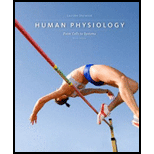
Concept explainers
The rate at which the
Want to see the full answer?
Check out a sample textbook solution
Chapter 4 Solutions
Human Physiology: From Cells to Systems (MindTap Course List)
- Describe the contribution of each of the following to establishing and maintaining membrane potential: (a) the Na+K+ pump, (b) passive movement of K+ across the membrane, (c) passive movement of Na+ across the membrane, and (d) the large intracellular anions.arrow_forwardConformational changes in channel proteins brought about by voltage changes are responsible for opening and closing Na+ and K+ gates during the generation of an action potential. (True or false?)arrow_forwardOne of the important uses of the Nernst equation is in describing the flow of ions across plasma membranes. Ions move under the influence of two forces: the concentration gradient (given in electrical units by the Nernst equation) and the electrical gradient (given by the membrane voltage). This is summarized by Ohms law: Ix=Gx(VmEx) which describes the movement of ion x across the membrane. I is the current in amperes (A); G is the conductance, a measure of the permeability of x, in Siemens (S), which is I/V;Vm is the membrane voltage; and Ex is the equilibrium potential of ion x. Not only does this equation tell how large the current is, but it also tells what direction the current is flowing. By convention, a negative value of the current represents either a positive ion entering the cell or a negative ion leaving the cell. The opposite is true of a positive value of the current. a. Using the following information, calculate the magnitude of Na [ Na+ ]0=145mM,[ Na+ ]i=15mM,Gna+=1nS,Vm=70mV b. Is Na+ entering or leaving the cell? c. Is Na+ moving with or against the concentration gradient? Is it moving with or against the electrical gradient?arrow_forward
- Choose the correct answer: A) When the voltage gated K+ channels open K+ moves down its concentration gradient from the ECF to inside the cell. O B) The value for resting membrane potential is closer to the EK+ (Equilibrium potential for K+) than the ENa+ O C) When the membrane potential is at rest the membrane is more permeable to Na+ than it is to K+ O D) Closing of the voltage-gated Na+ channels increases the permeability of the membrane to Na+arrow_forwardThe extracellular concentration of Cl-Cl¯ is 123 mM and the intracellular concentration is 4 mM. In which direction does Cl-CI¯| flow through an open channel when the membrane potential is in the -60 mV-60 mV to +30 mV+30 mV range?arrow_forwardThe following concentrations of Na+ and K+ ions: [Na+]o = 120 mM, [Na+]i = 6 mM,[K+]o = 2 mM, and [K+]i = 150 mM. Assuming that the further at the peak of the action potential, PK: PNa is 1 : 12. Calculate (Vm) at the peak of the action potentialarrow_forward
- What happens to the membrane potential when Na+/K+ pump is active?arrow_forwardConsider the effect of a twofold increase in the ECF concentration of Na+ or K+ ions. Which increase in ion concentration is the more deadly and why? Hint: Consider if the calculated decrease in or the increase in bring the resting membrane potential of the nerve or muscle cell closer to threshold potential? Why would this change in ion concentration stop the heart from beating?arrow_forwardA drug specifically blocks the Na+/K+ ATPase pump. What effect might this have on the action potential? O It will shorten the duration of the action potential as there will not be as many ions available to cross the membrane. None, as action potentials rely on channels for Na+ and K+ to cross the membrane, not pumps. It will not have an immediate effect, but eventually action potentials will stop as the Na+ and K+ gradients are depleted. It will make action potentials more likely to occur as the pump normally makes the cell more negative, so without it the membrane will reach threshold more easily.arrow_forward
- The resting potential is dependent upon the electrochemical gradient for potassium ions because: The permeability of the resting membrane to potassium is higher than for other ions Of the activity of the sodium/potassium ATPase pump Cells contain largely potassium The permeability to sodium ions is very small except during action potentialsarrow_forwardThe normal concentrations for intracellular and extracellular potassium in a neuron are [K+]in = 150 mM and [K+]out = 5 mM, respectively. Due to an electrolyte imbalance, a patient has the following intracellular and extracellular concentrations of potassium: [K+]in = 140 mM and [K+]out =2 mM. Using the Nernst equation (Chapter 4), calculate the equilibrium potential for potassium in the cells with normal K+ distributions and of the diseased patient. Refer back to Question #1. Will it be easier or more difficult to generate an action potential in the diseased neuron as compared to the normal neuron? Why?arrow_forwardWhat role do the Na+/K+ pumps play in establishing the resting membrane potential?arrow_forward
 Human Physiology: From Cells to Systems (MindTap ...BiologyISBN:9781285866932Author:Lauralee SherwoodPublisher:Cengage Learning
Human Physiology: From Cells to Systems (MindTap ...BiologyISBN:9781285866932Author:Lauralee SherwoodPublisher:Cengage Learning

